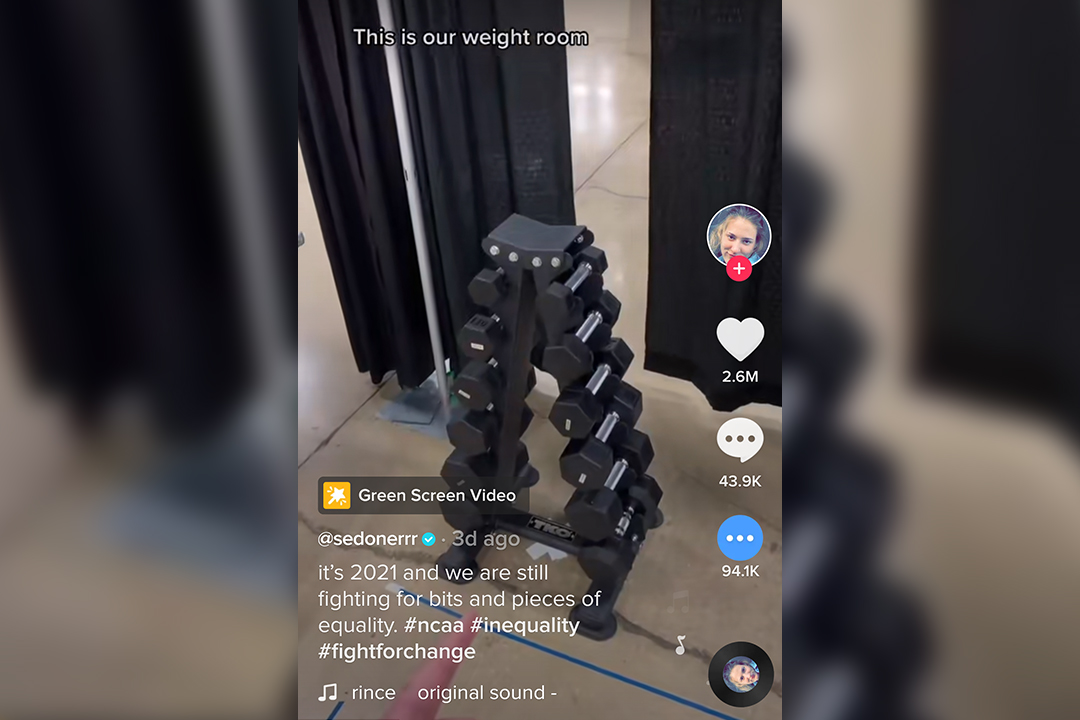As the name implies, March Madness is anything but predictable. Fans might watch their favourite teams get knocked out early on, and they might see underdogs make it further in the competition than they expected. In fact, none of the millions of public brackets predicted the 2021 Sweet 16 exactly.
But this year’s tournament got off to an unpredictable start for completely different reasons than usual.
Pictures and videos started circulating on social media of the shocking discrepancies between the women’s and men’s gym equipment, meals, and tournament merchandise provided by the National Collegiate Athletic Association (NCAA) for March Madness.
Stanford University Sports Performance Coach Ali Kershner posted a photo on Instagram comparing the women’s gym — made up of a small rack of dumbbells and yoga mats — and the men’s gym, which boasts impressive weights and machinery.
The images were all the more disheartening because they started circulating online so soon after International Women’s Day and during Women’s History Month.
The NCAA came out with a statement shortly after addressing the situation, recognizing that it “fell short this year” in its preparations. However, this situation is really a wake-up call about an overarching problem, as this is, unfortunately, not the only place in sports where women face barriers.
When women started to participate in sports in Canada at the end of the nineteenth century, they were mocked and put down for enjoying an activity that was, at the time, dominated by men. Obviously, we live in a different time now than we did then. But are things much better nowadays?
Several studies have shown that, unfortunately, the answer is no. The Rally Report, published by Canadian Women & Sport and Canadian Tire Jumpstart Charities, discovered that fewer university-aged women between the ages of 19 and 23 were playing sports at only 25 per cent, compared to university-aged men, at 49 per cent.
Why do women stop playing sports? Many women drop out during their teenage years for a number of complex and multifaceted reasons. The most common ones, though — cited by one in every three girls — were “low confidence,” “negative body image,” “perceived lack of skill,” or “feeling unwelcome.”
The inequality persists not just for athletes but for coaches too. For example, a report conducted by the International Journal of Sport Policy and Politics found that 84 per cent of head coaches registered with U SPORTS — the governing body for Canadian university sports — in the 2016–2017 season were men. Meanwhile, at the time of the study, the number of women head coaches had never risen higher than when it reached 19 per cent in 2010–2011.
What’s more, The Rally Report found that, between U SPORTS and the Canadian Collegiate Athletics Association together, 97 per cent of all-men sports teams had men head coaches, whereas all-women sports teams had women coaches only 26 per cent of the time.
Going forward, universities everywhere should encourage more women to both play on and coach their sports teams. On a larger scale, women’s professional sports around the world must be made more accessible and more readily available on major streaming services and television channels to empower young women athletes.
Organizations and teams should also continue to provide more opportunities for women. We have begun to see some of this already, such as the recent all-women broadcast of the Toronto Raptors game against the Denver Nuggets game and the first woman referee in the history of the Super Bowl.
Seeing women succeed in the sports industry is inspiring to women athletes, referees, coaches, and sports fans in general. Clearly, there is a long way to go. But hopefully, someday soon, we will achieve gender equality in sports.


